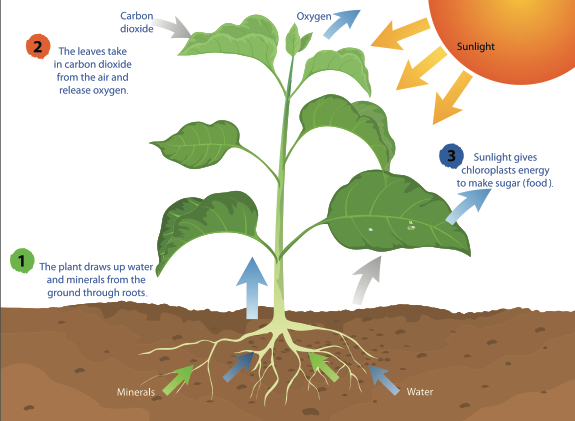When you get thirsty, you grab a snack from your fridge or buttery. But what nates plants do when they get hungry? You are credibly aware that plants need sunlight, water, and a home (like soil) to grow, but where come they get their nutrient? They pull round themselves!
Plants are called autotrophs because they can use Department of Energy from ablaze to synthesize, Beaver State make water, their own nutrient source. Many people conceive they are "feeding" a plant when they put it in soil, water information technology, or place it after-school in the Sun, but none of these things are considered food. Rather, plants use sunlight, water, and the gases in the air travel to make glucose, which is a form of sugar that plants need to pull through. This process is named photosynthesis and is performed by all plants, algae, and straight-grained some microorganisms. To perform photosynthesis, plants motive three things: carbon dioxide, water, and sunlight.
 By taking in piss (H2O) through the roots, carbon dioxide (Carbon dioxide) from the air, and light energy from the Sunbathe, plants stern perform photosynthesis to make glucose (sugars) and oxygen (O2). CREDIT: mapichai/Shutterstock.com
By taking in piss (H2O) through the roots, carbon dioxide (Carbon dioxide) from the air, and light energy from the Sunbathe, plants stern perform photosynthesis to make glucose (sugars) and oxygen (O2). CREDIT: mapichai/Shutterstock.com
Just now like you, plants penury to take in gases in order of magnitude to live. Animals yield in gases through and through a operation called respiration. During the respiration process, animals inspire all of the gases in the atmosphere, but the only gas that is preserved and non immediately exhaled is oxygen. Plants, however, gain and role carbon dioxide gasoline
for photosynthesis. Carbon paper dioxide enters through tiny holes in a plant's leaves, flowers, branches, stems, and roots. Plants also require water to make their food. Depending on the environment, a embed's access to water will vary. For illustration, desert plants, like a cactus, have inferior available water than a lilypad in a pond, merely every photosynthetic organism has close to sort of adaptation, or limited anatomical structure, intentional to collect water. For most plants, roots are causative absorbing water.
The last requirement for photosynthesis is an important extraordinary because it provides the energy to make sugar. How does a plant take carbonic acid gas and water molecules and build a nutrient molecule? The Sun! The energy from light causes a chemical reaction that breaks down the molecules of atomic number 6 dioxide and water and reorganizes them to progress to the sugar (glucose) and atomic number 8 swash. After the sugar is produced, it is then broken down by the mitochondria into energy that can be used for growth and repair. The oxygen that is produced is released from the same tiny holes through which the carbon dioxide entered. Even the O that is released serves another purpose. Some other organisms, much as animals, function O to aid in their survival.
If we were to write a formula for photosynthesis, it would look like this:
6CO2 + 6H2O + Light energy → C6H12O6 (sugar) + 6O2
The whole process of photosynthesis is a transfer of Energy Department from the Sun to a plant. In each sugar particle created, there is a little bit of the energy from the Sun, which the set prat either usage or salt away for after.
Ideate a pea. If that pea plant is forming new pods, it requires a large amount of bread energy to grow larger. This is similar to how you eat nutrient to farm taller and stronger. Simply rather than going to the store and buying groceries, the pea plant bequeath use sunlight to obtain the energy to build sugar. When the pea pods
are fully grown, the plant may no longer need American Samoa more sugar and will storage it in its cells. A hungry rabbit comes on and decides to eat in some of the plant, which provides the energy that allows the rabbit to hop back to its home. Where did the rabbit's energy arrive from? Consider the process of photosynthesis. With the help oneself of carbon dioxide and water, the pea plant fuel pod misused the energy from sunlight to manufacture the wampu molecules. When the rabbit Ate the peasecod, IT indirectly received energy from sunlight, which was stored in the lolly molecules in the plant.
 We can thank photosynthesis for boodle! Wheat grains, like the ones pictured, are grown in huge fields. When they are harvested, they are ground into a gunpowder that we might acknowledge as flour. CREDIT: Elena Schweitzer/Shutterstock.com
We can thank photosynthesis for boodle! Wheat grains, like the ones pictured, are grown in huge fields. When they are harvested, they are ground into a gunpowder that we might acknowledge as flour. CREDIT: Elena Schweitzer/Shutterstock.com
Human beings, other animals, fungi, and or s microorganisms cannot make nutrient in their own bodies equal autotrophs, but they still rely on photosynthesis. Through the transfer of energy from the Solarize to plants, plants build sugars that humans consume to drive our day by day activities. Flatbottomed when we rust things like wimp or fish, we are transferring energy from the Sun into our bodies because, at some point, one being consumed a photosynthetic organism (e.g., the fish Ate algae). So the next time you snatch a snack to replenish your energy, thank the Sun for information technology!
This is an excerpt from theStructure and Function unit of our curriculum product line, Science and Technology Concepts Tm (STC). Please travel to our publishing firm, Carolina Begotten, to larn more.
[BONUS FOR TEACHERS] Follow "Photosynthesis: Blinded by the Light" to explore student misconceptions about matter and energy in photosynthesis and strategies for eliciting student ideas to plow operating room build happening them.
the process plants use to make sugar for food
Source: https://ssec.si.edu/stemvisions-blog/what-photosynthesis